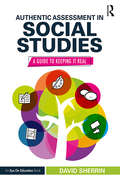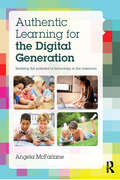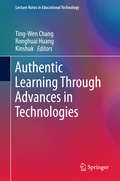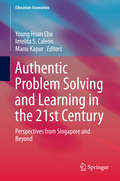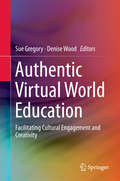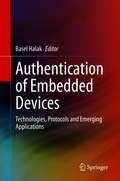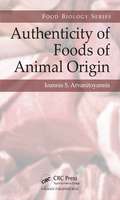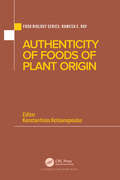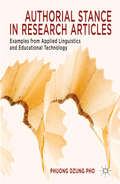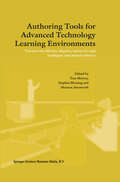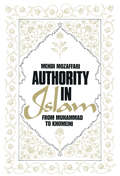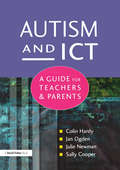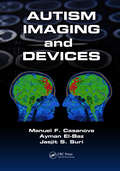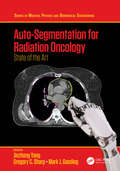- Table View
- List View
Authentic Assessment in Social Studies: A Guide to Keeping it Real
by David SherrinThis engaging book will show you how to move beyond tests and essay writing to implement authentic assessments in your middle or high school social studies classroom. Award-winning teacher David Sherrin explains the value of authentic assessments and offers practical ways to get started and dive deeper in your own practice. You&’ll be encouraged and inspired by the real-life stories of classroom successes and failures that illustrate the points throughout the book. The chapters cover a range of categories, including different types of written, creative, and civic action assessments. The book includes: planning charts and rubrics showing how to use, grade, and give feedback on assessments so they truly aid student learning and progress specific examples, useful tips, and ready-to-go instructions that you can use immediately with your class open-ended assessments encourage scaffolding or adaptation for individual or group work to fit your classroom needs You will learn how to personalize instruction and provide students with avenues for creativity and the types of learning experiences they need to be prepared for a complex world.
Authentic Assessment in Social Studies: A Guide to Keeping it Real
by David SherrinThis engaging book will show you how to move beyond tests and essay writing to implement authentic assessments in your middle or high school social studies classroom. Award-winning teacher David Sherrin explains the value of authentic assessments and offers practical ways to get started and dive deeper in your own practice. You&’ll be encouraged and inspired by the real-life stories of classroom successes and failures that illustrate the points throughout the book. The chapters cover a range of categories, including different types of written, creative, and civic action assessments. The book includes: planning charts and rubrics showing how to use, grade, and give feedback on assessments so they truly aid student learning and progress specific examples, useful tips, and ready-to-go instructions that you can use immediately with your class open-ended assessments encourage scaffolding or adaptation for individual or group work to fit your classroom needs You will learn how to personalize instruction and provide students with avenues for creativity and the types of learning experiences they need to be prepared for a complex world.
Authentic Learning for the Digital Generation: Realising the potential of technology in the classroom
by Angela McFarlaneWhy should we use technology to support learning? Where does the responsibility lie to prepare young people to be active and successful cybercitizens? Can we go on confiscating pupils’ smartphones indefinitely? Authentic Learning for the Digital Generation is a vital examination of young people’s use of personal devices, online creative communities and digital gaming. It calls into question the idea of the ‘digital native’ and shows clearly that the majority of young users need help and support in order to benefit from the rich learning potential of personal, mobile and online technology use. Written by a leading authority on the role of digital technologies in education, it looks in detail at the practice and implications of learning using personal devices, collaborative online spaces, learning platforms, user generated content and digital games. In particular, approaches to solving problems, building knowledge, manipulating data and creating texts are examined. It offers clear strategies, a vision for what effects on learning we might reasonably expect when children are given access to different types of technology, and explores the challenges of managing these practices in the classroom. Authentic Learning for the Digital Generation offers careful analysis at a time when there is much discussion about young people emerging from school unprepared for the world of work and often struggling to manage their personal relationships as they are exposed to strong content and harsh criticism online. It considers what we know of childhood experience in a digital world and offers ways in which schools and teachers can embrace the opportunity presented by ubiquitous ownership of connected, digital devices to enrich and deepen learning.
Authentic Learning for the Digital Generation: Realising the potential of technology in the classroom
by Angela McFarlaneWhy should we use technology to support learning? Where does the responsibility lie to prepare young people to be active and successful cybercitizens? Can we go on confiscating pupils’ smartphones indefinitely? Authentic Learning for the Digital Generation is a vital examination of young people’s use of personal devices, online creative communities and digital gaming. It calls into question the idea of the ‘digital native’ and shows clearly that the majority of young users need help and support in order to benefit from the rich learning potential of personal, mobile and online technology use. Written by a leading authority on the role of digital technologies in education, it looks in detail at the practice and implications of learning using personal devices, collaborative online spaces, learning platforms, user generated content and digital games. In particular, approaches to solving problems, building knowledge, manipulating data and creating texts are examined. It offers clear strategies, a vision for what effects on learning we might reasonably expect when children are given access to different types of technology, and explores the challenges of managing these practices in the classroom. Authentic Learning for the Digital Generation offers careful analysis at a time when there is much discussion about young people emerging from school unprepared for the world of work and often struggling to manage their personal relationships as they are exposed to strong content and harsh criticism online. It considers what we know of childhood experience in a digital world and offers ways in which schools and teachers can embrace the opportunity presented by ubiquitous ownership of connected, digital devices to enrich and deepen learning.
Authentic Learning Through Advances in Technologies (Lecture Notes in Educational Technology)
by Ting-Wen Chang Ronghuai Huang KinshukThis book introduces the advanced technologies used for authentic learning, an educational term that refers to a variety of techniques focusing on how students apply the skills and knowledge acquired in school in real-world situations. In the meanwhile, it presents the latest trends and future developments in learning design, learning environment and assessment for authentic learning using advances in technology, this book discusses how technology supports authentic learning and what makes it effective.
Authentic Problem Solving and Learning in the 21st Century: Perspectives from Singapore and Beyond (Education Innovation Series)
by Young Hoan Cho Imelda S. Caleon Manu KapurWith the rapid changes in the social, political, economic and technological landscape around the world, today’s learners face a more globally competitive job market after leaving school. The 21st century, which is characterized by the emergence of knowledge-based societies, expects learners to be comfortable in dealing with ambiguities and complexities in the real world and to be able to use knowledge as a tool at their workplace. This book will help readers develop an in-depth understanding of authentic problem solving and learning, and how it can be used to make a difference in their school or learning communities for the development of 21st century competencies. Comprising 20 chapters written by Singapore-based and international authors, the book is organized into three themes: authentic problems, authentic practices, and authentic participation. It details innovative school practices (e.g. productive failure) concerning the design of problems, learning activities, learning environments, and ICT tools for authentic problem solving and learning. Along with theoretical explanations of authentic learning processes and outcomes, the book also elucidates how students learn by generating and exploring solutions to complex problems and which cognitive functions are needed at different stages of problem-based learning. Presenting coherent descriptions of instructional design principles, successful cases and challenges encountered in K-12 schools and learning communities, the book provides useful information, new insights, and practical guidance for school directors, parents, teachers and researchers seeking to develop authentic learning environments for 21st century learners.
Authentic Virtual World Education: Facilitating Cultural Engagement and Creativity
by Sue Gregory Denise WoodThe book presents the possibilities and realities of virtual worlds in education through the application of 3D virtual worlds to support authentic learning, creativity, learner engagement and cultural diversity in higher education. It includes a unique variety of cross disciplinary approaches to research, teaching and learning in a virtual world, including analysis of data from the experiences of students in education, law, Chinese language, sustainability, computer architecture, business, health and the Arts. The book provides unique learning experiences that have celebrated the rich media of virtual world environments through the utilisation of affordances such as simulation, bots, synchronous interaction, machinima and games. The perspectives come from Australia and New Zealand higher education academics but transferable to any higher educational institution in the sector, worldwide, and is significant to various disciplines in the higher education field.
Authentication of Embedded Devices: Technologies, Protocols and Emerging Applications
by Basel HalakThis book provides comprehensive coverage of state-of-the-art integrated circuit authentication techniques, including technologies, protocols and emerging applications.The authors first discuss emerging solutions for embedding unforgeable identifies into electronics devices, using techniques such as IC fingerprinting, physically unclonable functions and voltage-over-scaling. Coverage then turns to authentications protocols, with a special focus on resource-constrained devices, first giving an overview of the limitation of existing solutions and then presenting a number of new protocols, which provide better physical security and lower energy dissipation. The third part of the book focuses on emerging security applications for authentication schemes, including securing hardware supply chains, hardware-based device attestation and GPS spoofing attack detection and survival.Provides deep insight into the security threats undermining existing integrated circuit authentication techniques;Includes an in-depth discussion of the emerging technologies used to embed unforgeable identifies into electronics systems;Offers a comprehensive summary of existing authentication protocols and their limitations;Describes state-of-the-art authentication protocols that provide better physical security and more efficient energy consumption;Includes detailed case studies on the emerging applications of IC authentication schemes.
Authenticity and Wooden Architecture Preservation in Asia – a Chinese perspective
by Tomasz TomaszekThe tradition of Chinese wooden architecture dates back to ancient times. The construction solutions developed in this country over the centuries enchant with their refined character, while the historical wooden structures delight future generations with their dignity and aesthetic excellence. China`s wooden architecture, deeply rooted in its spiritual and religious traditions, is undoubtedly the pinnacle of this type of building in Asian culture. At the same time, it is a testimony to the national identity and reflects the specificity of the country`s material heritage. The accelerated social and economic changes in China and the constantly advancing globalization of the world have contributed to this country’s assimilation of Western concepts related to the protection of cultural heritage. The issue of authenticity in the preservation of wooden built heritage proved particularly problematic. This book brings closer the theoretical understanding and practical application of the idea of authenticity from Chinese perspective. To do this, the issue of living heritage and the reception and understanding of traditional Chinese wooden architecture and its preservation as a direct materialization of Chinese religious and philosophical traditions is discussed. The above topics are treated within the cyclic concept of time, i.e. in terms of progress and repetition, with preservation being understood as a religious practice. Finally, trends in the preservation of wooden heritage in present-day China are mentioned, including new attempts to interpret the tradition and the reinvention of the tradition of wooden building. The book aims to contribute to the understanding of the protection of wooden architectural heritage in China from a new perspective, and will be of particular interest to academics and professionals interested in or involved in the preservation of built wooden heritage. ‘(…) a highly valuable contribution to the field of wooden architecture protection and preservation’, Xiaoming Zhu (Tongji University, Shanghai, China) This book ‘(…) successfully explains the inheritance characteristics of Chinese wooden architectures from the perspective of cultural philosophy for a wide audience (…)’, Yasufumi Uekita, University of Tsukuba, Ibaraki, Japan
Authenticity and Wooden Architecture Preservation in Asia – a Chinese perspective
by Tomasz TomaszekThe tradition of Chinese wooden architecture dates back to ancient times. The construction solutions developed in this country over the centuries enchant with their refined character, while the historical wooden structures delight future generations with their dignity and aesthetic excellence. China`s wooden architecture, deeply rooted in its spiritual and religious traditions, is undoubtedly the pinnacle of this type of building in Asian culture. At the same time, it is a testimony to the national identity and reflects the specificity of the country`s material heritage. The accelerated social and economic changes in China and the constantly advancing globalization of the world have contributed to this country’s assimilation of Western concepts related to the protection of cultural heritage. The issue of authenticity in the preservation of wooden built heritage proved particularly problematic. This book brings closer the theoretical understanding and practical application of the idea of authenticity from Chinese perspective. To do this, the issue of living heritage and the reception and understanding of traditional Chinese wooden architecture and its preservation as a direct materialization of Chinese religious and philosophical traditions is discussed. The above topics are treated within the cyclic concept of time, i.e. in terms of progress and repetition, with preservation being understood as a religious practice. Finally, trends in the preservation of wooden heritage in present-day China are mentioned, including new attempts to interpret the tradition and the reinvention of the tradition of wooden building. The book aims to contribute to the understanding of the protection of wooden architectural heritage in China from a new perspective, and will be of particular interest to academics and professionals interested in or involved in the preservation of built wooden heritage. ‘(…) a highly valuable contribution to the field of wooden architecture protection and preservation’, Xiaoming Zhu (Tongji University, Shanghai, China) This book ‘(…) successfully explains the inheritance characteristics of Chinese wooden architectures from the perspective of cultural philosophy for a wide audience (…)’, Yasufumi Uekita, University of Tsukuba, Ibaraki, Japan
Authenticity of Foods of Animal Origin
by Ioannis Sotirios ArvanitoyannisOver the last 20-30 years the number of food poisoning incidents has increased considerably and this has had disastrous effects both on consumers and the food industry. Several food industries went bankrupt due to huge amounts of money paid to compensate consumers' family/relatives. These unfortunate incidents triggered consumer and governmental aw
Authenticity of Foods of Plant Origin (Food Biology Series)
by Konstantinos KotsanopoulosFood is adulterated to increase profit or due to negligence. Adulteration can compromise food safety and quality, and harm consumers. This may undermine consumer trust and the reputation of the food industry. As such, it is very important to monitor, control and detect adulteration. A number of techniques have been developed for the authentication of food and verifying its quality and associated claims. Foods of plant origin are the source of nutrients for billions of people around the globe. Due to the huge variety of plants, and the lack of visual characteristics as a result of processing, advanced techniques are required to detect adulteration. This book reviews the latest developments in the field of authenticity of foods of plant origin, examining concepts such as traceability, and how they are applied to facilitate the support of claims, as well as legislative requirements in the major economies around the world. The basic techniques used nowadays in verifying authenticity of these types of foods are reviewed and discussed, and their applications are summarized. The book also focuses on categories of foods most prone to adulteration attempts due to their characteristics, properties and production methods commonly followed, thus allowing the reader to more easily identify the chapter that is of interest in each case. The book will be of interest to food industrialists, chemists, quality control scientists and technologists, microbiologists, analytical chemists and food physical chemists within the food industry. It is also aimed at academicians who are interested in the authenticity of foods of plant origin and the advancements in the analytical fields that support relevant legal and marketing requirements.
Authenticity of Foods of Plant Origin (Food Biology Series)
by Konstantinos KotsanopoulosFood is adulterated to increase profit or due to negligence. Adulteration can compromise food safety and quality, and harm consumers. This may undermine consumer trust and the reputation of the food industry. As such, it is very important to monitor, control and detect adulteration. A number of techniques have been developed for the authentication of food and verifying its quality and associated claims. Foods of plant origin are the source of nutrients for billions of people around the globe. Due to the huge variety of plants, and the lack of visual characteristics as a result of processing, advanced techniques are required to detect adulteration. This book reviews the latest developments in the field of authenticity of foods of plant origin, examining concepts such as traceability, and how they are applied to facilitate the support of claims, as well as legislative requirements in the major economies around the world. The basic techniques used nowadays in verifying authenticity of these types of foods are reviewed and discussed, and their applications are summarized. The book also focuses on categories of foods most prone to adulteration attempts due to their characteristics, properties and production methods commonly followed, thus allowing the reader to more easily identify the chapter that is of interest in each case. The book will be of interest to food industrialists, chemists, quality control scientists and technologists, microbiologists, analytical chemists and food physical chemists within the food industry. It is also aimed at academicians who are interested in the authenticity of foods of plant origin and the advancements in the analytical fields that support relevant legal and marketing requirements.
Authorial Stance in Research Articles: Examples from Applied Linguistics and Educational Technology
by P. PhoHow do I structure a journal article?; "Can I use 'I' in a research article?"; "Should I use an active or passive voice?" - Many such questions will be answered in this book, which documents the linguistic devices that authors use to show how they align or distance themselves from arguments and ideas, while maintaining conventions of objectivity.
Authoring Tools for Advanced Technology Learning Environments: Toward Cost-Effective Adaptive, Interactive and Intelligent Educational Software
by T. Murray S. Blessing S. AinsworthThis edited book gives a comprehensive picture of the state of the art in authoring systems and authoring tools for advanced technology instructional systems. It includes descriptions of fifteen systems and research projects from almost every significant effort in the field. The book will appeal to researchers, teachers and advanced students working in education, instructional technology and computer-based education, psychology, cognitive science and computer science.
Authority: The Southern Reach Trilogy: Annihilation, Authority,acceptance (The Southern Reach Trilogy #2)
by null Jeff VanderMeer’A contemporary masterpiece’ Guardian THE SECOND VOLUME OF THE EXTRAORDINARY SOUTHERN REACH TRILOGY – NOW A MAJOR MOTION PICTURE WRITTEN AND DIRECTED BY ALEX GARLAND (EX MACHINA) AND STARRING NATALIE PORTMAN, OSCAR ISAAC, GINA RODRIGUEZ AND TESSA THOMPSON Following the disastrous twelfth expedition chronicled in ‘Annihilation’, the second book of the Southern Reach trilogy introduces John Rodriguez, the new head of the government agency responsible for the safeguarding of Area X. His first day is spent grappling with the fall-out from the last expedition. Area X itself remains a mystery. But, as instructed by a higher authority known only as The Voice, the self-styled Control must battle to ‘put his house in order’. From a series of interrogations, a cache of hidden notes and hours of profoundly troubling video footage, the mysteries of Area X begin to reveal themselves—and what they expose pushes Control to confront disturbing truths about both himself and the agency he’s promised to serve. Undermined and under pressure to make sense of everything, Rodriguez retreats into his past in a labyrinthine search for answers. Yet the more he uncovers, the more he risks, for the secrets of the Southern Reach are more sinister than anyone could have known.
The Authority Gap: Why women are still taken less seriously than men, and what we can do about it
by Mary Ann Sieghart'A brilliant manifesto explaining why women are still so underestimated and overlooked in today's world, but how we can also be hopeful for change' - Philippa Perry'Hugely exciting' - Emily Maitlis__________Imagine living in a world in which you were routinely patronised by women.Imagine having your views ignored or your expertise frequently challenged by them.Imagine people always addressing the woman you are with before you.Now imagine a world in which the reverse of this is true.The Authority Gap provides a startling perspective on the unseen bias at work in our everyday lives, to reveal the scale of the gap that still persists between men and women. Would you believe that US Supreme Court Justices are interrupted four times more often than male ones... 96% of the time by men? Or that British parents, when asked to estimate their child's IQ will place their son at 115 and their daughter at 107?Marshalling a wealth of data with precision and insight, and including interviews with pioneering women such as Baroness Hale, Mary Beard and Bernadine Evaristo, Mary Ann exposes unconscious bias in this fresh feminist take on how to address and counteract systemic sexism in ways that benefit us all.Includes interviews with pioneering women such as:Baroness HaleMary BeardBernadine EvaristoMary McAleeseJulia GillardDolly Alderton and Pandora SykesCherie BlairLiz TrussAmber RuddFrances MorrisLaura Bates__________'Deeply researched, profoundly thoughtful and a book very much for the here and now: Mary Ann Sieghart's The Authority Gap is the book she was probably born to write' - Andrew Marr'At last here is a credible roadmap that is capable of taking women from the margins to the centre by bridging the authority gap that holds back even the best and most talented of women. - Mary McAleese, Former President of Ireland
Authority in Islam: From Mohammed to Khomeini
by Mehdi MozaffariThis text looks at the future orientation of the People's Liberation Army. It covers military leadership, readiness and expenditure, defense doctrine, high-tech warfare acquisitions, the scientific and technological base for defense procurement and China's security concerns in Northeast Asia.
Authority in Islam: From Mohammed to Khomeini
by Mehdi MozaffariThis text looks at the future orientation of the People's Liberation Army. It covers military leadership, readiness and expenditure, defense doctrine, high-tech warfare acquisitions, the scientific and technological base for defense procurement and China's security concerns in Northeast Asia.
Autism and ICT: A Guide for Teachers and Parents
by Julie Newman Sally Cooper Colin Hardy Jan OgdenThis book offers a practical approach for staff and carers who want to develop the use of ICT for children on the autistic spectrum and for those with language and communication difficulties. It combines descriptions of current research and literature on the subject of autism and ICT with practical guidance on software and hardware. A practical approach encourages experimentation, values the skills and attributes that participants bring and minimizes the technical barrier to ICT use. It includes concise information on what autism is, and examples of a range of pupils and their typical learning behaviors. It offers advice on how ICT can relate to various aspects of autism, information on concept keyboards and touch-sensitive screens and switches, and help with buying a computer and using the internet. Teachers, carers and parents of children with autism or language and communication problems will find lots of useful suggestions and advice on how to use ICT to help access the curriculum.
Autism and ICT: A Guide for Teachers and Parents
by Julie Newman Sally Cooper Colin Hardy Jan OgdenThis book offers a practical approach for staff and carers who want to develop the use of ICT for children on the autistic spectrum and for those with language and communication difficulties. It combines descriptions of current research and literature on the subject of autism and ICT with practical guidance on software and hardware. A practical approach encourages experimentation, values the skills and attributes that participants bring and minimizes the technical barrier to ICT use. It includes concise information on what autism is, and examples of a range of pupils and their typical learning behaviors. It offers advice on how ICT can relate to various aspects of autism, information on concept keyboards and touch-sensitive screens and switches, and help with buying a computer and using the internet. Teachers, carers and parents of children with autism or language and communication problems will find lots of useful suggestions and advice on how to use ICT to help access the curriculum.
Autism Imaging and Devices
by Manuel F. Casanova Ayman El-Baz Jasjit S. SuriThis book covers state-of-the-art medical image analysis approaches currently pursued in autism research. Chapters cover recent advances in diagnosis using structural neuroimaging. All aspects of imaging are included, such as electrophysiology (EEG, ERP, QEEG, and MEG), postmortem techniques, and advantages and difficulties of depositing/acquiring images in larger databases. The book incorporates 2D, 3D, and 4D imaging and advances scientific research within the broad field of autism imaging.
Autism Imaging and Devices
by Jasjit S. Suri Manuel F. Casanova Ayman El-BazThis book covers state-of-the-art medical image analysis approaches currently pursued in autism research. Chapters cover recent advances in diagnosis using structural neuroimaging. All aspects of imaging are included, such as electrophysiology (EEG, ERP, QEEG, and MEG), postmortem techniques, and advantages and difficulties of depositing/acquiring images in larger databases. The book incorporates 2D, 3D, and 4D imaging and advances scientific research within the broad field of autism imaging.
Auto-Segmentation for Radiation Oncology: State of the Art (Series in Medical Physics and Biomedical Engineering)
by Jinzhong Yang, Gregory C. Sharp, and Mark J. GoodingThis book provides a comprehensive introduction to current state-of-the-art auto-segmentation approaches used in radiation oncology for auto-delineation of organs-of-risk for thoracic radiation treatment planning. Containing the latest, cutting edge technologies and treatments, it explores deep-learning methods, multi-atlas-based methods, and model-based methods that are currently being developed for clinical radiation oncology applications. Each chapter focuses on a specific aspect of algorithm choices and discusses the impact of the different algorithm modules to the algorithm performance as well as the implementation issues for clinical use (including data curation challenges and auto-contour evaluations). This book is an ideal guide for radiation oncology centers looking to learn more about potential auto-segmentation tools for their clinic in addition to medical physicists commissioning auto-segmentation for clinical use. Features: Up-to-date with the latest technologies in the field Edited by leading authorities in the area, with chapter contributions from subject area specialists All approaches presented in this book are validated using a standard benchmark dataset established by the Thoracic Auto-segmentation Challenge held as an event of the 2017 Annual Meeting of American Association of Physicists in Medicine
Auto-Segmentation for Radiation Oncology: State of the Art (Series in Medical Physics and Biomedical Engineering)
by Jinzhong Yang Gregory C. Sharp Mark J. GoodingThis book provides a comprehensive introduction to current state-of-the-art auto-segmentation approaches used in radiation oncology for auto-delineation of organs-of-risk for thoracic radiation treatment planning. Containing the latest, cutting edge technologies and treatments, it explores deep-learning methods, multi-atlas-based methods, and model-based methods that are currently being developed for clinical radiation oncology applications. Each chapter focuses on a specific aspect of algorithm choices and discusses the impact of the different algorithm modules to the algorithm performance as well as the implementation issues for clinical use (including data curation challenges and auto-contour evaluations). This book is an ideal guide for radiation oncology centers looking to learn more about potential auto-segmentation tools for their clinic in addition to medical physicists commissioning auto-segmentation for clinical use. Features: Up-to-date with the latest technologies in the field Edited by leading authorities in the area, with chapter contributions from subject area specialists All approaches presented in this book are validated using a standard benchmark dataset established by the Thoracic Auto-segmentation Challenge held as an event of the 2017 Annual Meeting of American Association of Physicists in Medicine
